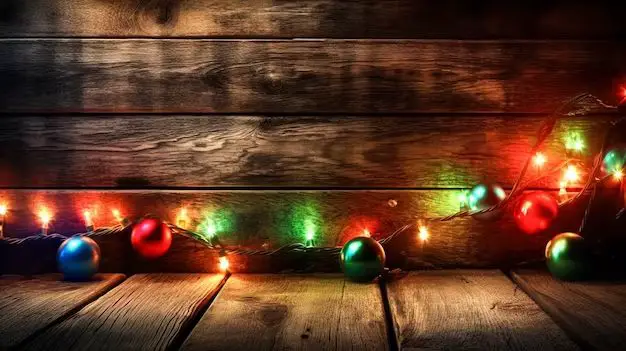Christmas lights have become a beloved holiday tradition, ushering in the festive spirit with their warm glow. While today’s LED lights come in every color under the rainbow, vintage Christmas lights from the mid-20th century and earlier had a more limited color palette. So what were the original Christmas light colors and why were they chosen? Let’s take a nostalgic stroll down memory lane to explore the history of vintage Christmas light colors.
Page Contents
The Origins of Christmas Lights
Christmas lights actually originated in Germany in the 17th century, when candles were attached to Christmas trees to symbolize the stars in the night sky over Bethlehem. This custom spread throughout Europe and eventually electric Christmas lights were invented in the 1880s.
The very first electric Christmas lights consisted of strands of large, pear-shaped bulbs about the size of a walnut. They were hand-wired and very expensive, so only the wealthy could afford them initially. As more homes gained access to electricity in the 1920s and 1930s and costs came down, miniature lights became popular.
The Color Palette of Early 20th Century Lights
Since the first electrical Christmas light strands were extremely expensive, they were made with the most readily available bulbs of the period. This limited the color options to clear, white, and red.
Thedominant colors were:
- Clear: Also known as transparent or colorless, these bulbs allowed the filament to be visible and produced a bright, sparkling light.
- White: Opaque white bulbs gave off a warmer, glowing illumination.
- Red: Red bulbs were also common and established the classic Christmas color scheme.
As Christmas lights became more affordable in the 1920s, a few additional colors were introduced:
- Green: Dark green bulbs complemented the red ones nicely.
- Blue: Light blue bulbs added cool tone contrast.
- Orange: Darker amber/orange shades provided a rich, vintage look.
But the palette remained limited. It wasn’t until the 1960s that technology allowed a full spectrum of colors for Christmas lights.
Why Were Red, Green, White, and Blue So Common?
There were a few key factors that made red, green, white, and blue the most popular vintage Christmas light colors:
Availability –
As mentioned earlier, the first bulbs were only manufactured in clear, white, and red. Red dye was common and inexpensive. Green and blue came later when colored glass technology expanded.
Meaning –
In addition to availability, these colors held special meaning:
- White – White lights evoked purity, peace, and the glow of snow.
- Red – Red symbolized the blood of Christ and was closely associated with the Christmas season.
- Green – Green represented the eternal life promised by Christ and hope.
- Blue – Blue referenced heavenly skies and was seen as calming.
American Traditions –
The red, white, and blue combination aligned with American patriotic colors, which increased their appeal.
Complementary Colors –
Red and green are complementary colors on the color wheel, providing a pleasing visual contrast.
The Evolution of Christmas Light Colors
While the first Christmas light colors were quite limited, the palette steadily expanded decade by decade:
| Decade | New Christmas Light Colors |
|---|---|
| 1920s | Orange |
| 1930s | Blue |
| 1940s | No new colors due to WWII shortages |
| 1950s | Pastel shades like pink, purple, turquoise |
| 1960s | Multicolor light sets |
The development of the first outdoor miniature light sets in the 1920s enabled more homes to decorate. But with only large red, white, and green bulbs available, the schemes were simple: solid colors or alternating red and green strings.
It wasn’t until the 1960s that technology enabled mass production of the tiny lights recognizable today and allowed mixing multiple colors on one strand. Christmas light innovation accelerated through the 1990s with the invention of LED lights, introducing light shows synchronized to music.
While trends continue to evolve, the vintage palette of red, green, blue, and white endures as a historical favorite.
Notable Vintage Christmas Light Brands
A few major manufacturers dominated the vintage Christmas light market in the mid-20th century:
GE (General Electric)
GE produced the first mass-marketed Christmas light sets in the 1920s. Their orange and blue lights were hot sellers in the 1930s and 1940s.
Fun fact: In 1963, GE scientists invented the first outdoor miniature light set, paving the way for ubiquitous Christmas decorating.
NOMA
NOMA was GE’s biggest competitor and also debuted mini lights in the 1960s. They were known for their bubble lights, candle-shaped lights, and the “icicle” light series.
Westinghouse
Westinghouse likewise manufactured novelty Christmas lights including the popular “Midget-Bubbl-Lite” bulbs in the 1940s and 1950s.
Vintage-Inspired Christmas Décor
While today’s LED Christmas lights outshine vintage versions in brightness, efficiency, and color options, many retain a soft spot for the nostalgic ambiance of the old-fashioned bulbs. Some ideas for integrating vintage-style lights:
- Search flea markets or online auctions for strands of classic large C7, C9, or bubble lights for decoration or to line walkways.
- Mix strings of LED lights in classic colors like clear, red, blue, and green into displays for retro appeal.
- Use ceramic replicas of vintage bulbs as Christmas tree ornaments.
- Display vintage Christmas light boxes or advertisements as retro decorations.
The familiar glow of traditional Christmas lights brings back memories of holidays past. While white LED lights have come to dominate modern decorating, the signature reds and greens of vintage lights hold enduring nostalgic charm.
Conclusion
Christmas lights have come a long way since their inception in 17th century Germany. The early color palette was driven by availability and meaning, focused on red, green, white, and blue. As lighting technology advanced through the 1960s, the possibilities expanded dramatically. While unlimited colors and programmable shows dazzle today, the simple magic of classic vintage lights lives on. The next time you unpack your Christmas decorations or visit a holiday display, take a moment to appreciate how the classic colors of vintage Christmas lights still shine bright.
